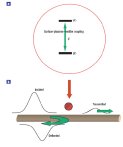Physicists in the US and Denmark have unveiled plans for an all-optical transistor-like device that can be turned on by a single photon. The device -- which has not yet been built -- consists of a single atom that can control the passage of individual photons travelling along a thin nanowire. Single-photon transistors of this type could someday be used to make highly-efficient photon detectors, optical communications systems and quantum computers (Nature Physics doi:10.1038/nphys708).

It is normally very difficult to use single photons from one beam of light to control another beam because photons rarely interact with each other. Physicists believe that the way to get photons to interact with each other is to “squeeze” them into tiny spaces such as a quantum dot or even a single atom in an optical cavity. Squeezing the photons is essential because it intensifies their electromagnetic fields, thereby increasing the chances that they will interact.
Now, Mikhail Lukin and fellow physicists at Harvard University along with a colleagues at the Niels Bohr Institute in Copenhagen have proposed a new way of doing this by focusing photons onto tiny metallic nanowires. Here they are converted into surface plasmons – oscillations of conduction electrons – which travel along the nanowire. This process is analogous to sending a radio wave along a coaxial cable and squeezes the photons into a space that is smaller than their wavelength.
Lukin and colleagues have calculated that if a single atom is placed near the nanowire, it will absorb the first plasmon pulse that passes by, leaving the atom in an excited state. The excited atom will be unable to absorb subsequent photons and the transistor will be in the “on” position. The device could be switched “off” by firing either another single photon or a conventional laser pulse at it, causing the excited state to decay.
According to Lukin, the advantage of using a nanowire – rather than an optical cavity – to squeeze the photons is that a nanowire device would work over a wide range of wavelengths, whereas optical cavities are tuned and therefore will only work at certain frequencies.
The researchers believe that the device could someday be used as a very efficient single-photon detector in optical communication. They also point out that the device could function as a quantum logic gate that could be used in quantum computers. Key challenges in building a real device include identifying a suitable atom that can be strongly coupled to nanowire plasmons and connecting a fibre-optic cable to the nanowire to ensure that the photons are transmitted in and out of the device.
Lukin told physicsworld.com that the team is trying to build a device in the laboratory using artificial atoms such as quantum dots.


